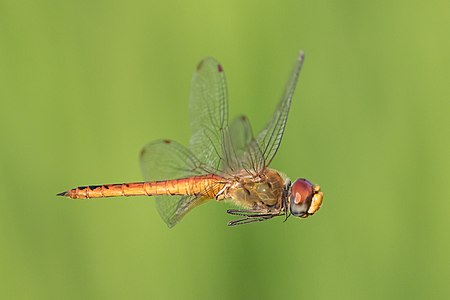Talk:Pantala flavescens
| This article is rated C-class on Wikipedia's content assessment scale. It is of interest to the following WikiProjects: | ||||||||||||||||||||||||||||||
| ||||||||||||||||||||||||||||||
| This article contains a translation of Wanderlibelle from de.wikipedia. |
Translation from German
[edit]The original has a description of the Hamulus that I could not translate due to lack of knowledge of Odonata sexual anatomy!
- Am Hamulus, einem kleinen hakenförmigen Fortsatz am sekundären Geschlechtsorgan der Männchen, fehlt der äußere Ast oder ist vielmehr nur durch einen Wulst angedeutet. Beim Weibchen wiederum befinden sich auf dem letzten Segment der kahnförmigen Bauchplatte zwei kurze Scheidentaster.
which Google translated as:
- On Hamulus, a small hook survival rate of the secondary sex organs of the male, lacking the outer branch is much longer, or only indicated by a bead. Beim Weibchen wiederum befinden sich auf dem letzten Segment der kahnförmigen Bauchplatte zwei kurze Scheidentaster. In turn, females are on the last segment of the abdominal plate kahnförmigen two short vaginal probe
--Alastair Rae (talk) 12:56, 15 July 2009 (UTC)
File:Wandering glider horizontal edit1.jpg to appear as POTD soon
[edit]Hello! This is a note to let the editors of this article know that File:Wandering glider horizontal edit1.jpg will be appearing as picture of the day on January 16, 2011. You can view and edit the POTD blurb at Template:POTD/2011-01-16. If this article needs any attention or maintenance, it would be preferable if that could be done before its appearance on the Main Page so Wikipedia doesn't look bad. :) Thanks! howcheng {chat} 19:21, 13 January 2011 (UTC)
External links modified (January 2018)
[edit]Hello fellow Wikipedians,
I have just modified 6 external links on Pantala flavescens. Please take a moment to review my edit. If you have any questions, or need the bot to ignore the links, or the page altogether, please visit this simple FaQ for additional information. I made the following changes:
- Added archive https://web.archive.org/web/20110202143115/http://www.mrc.gov.mv/index.php/download_file/-/view/773 to http://www.mrc.gov.mv/index.php/download_file/-/view/773
- Added
{{dead link}}tag to http://www.fmnh.helsinki.fi/users/haaramo/Metazoa/Protostoma/Arthropoda/Insecta/Palaeoptera/Neolamellida.html - Added archive https://web.archive.org/web/20020712060637/http://www.libellula.org/stamps/1970_1979.htm to http://www.libellula.org/stamps/1970_1979.htm
- Added archive https://web.archive.org/web/20051217134710/http://www.libellula.org/stamps/1980_1984.htm to http://www.libellula.org/stamps/1980_1984.htm
- Added archive https://web.archive.org/web/20020909011820/http://www.libellula.org/stamps/1995_1999.htm to http://www.libellula.org/stamps/1995_1999.htm
- Added archive https://web.archive.org/web/20051217140309/http://www.libellula.org/stamps/2003_2005.htm to http://www.libellula.org/stamps/2003_2005.htm
- Added archive https://web.archive.org/web/20051109103551/http://www.greglasley.net/wanglider.html to http://www.greglasley.net/wanglider.html
When you have finished reviewing my changes, you may follow the instructions on the template below to fix any issues with the URLs.
This message was posted before February 2018. After February 2018, "External links modified" talk page sections are no longer generated or monitored by InternetArchiveBot. No special action is required regarding these talk page notices, other than regular verification using the archive tool instructions below. Editors have permission to delete these "External links modified" talk page sections if they want to de-clutter talk pages, but see the RfC before doing mass systematic removals. This message is updated dynamically through the template {{source check}} (last update: 5 June 2024).
- If you have discovered URLs which were erroneously considered dead by the bot, you can report them with this tool.
- If you found an error with any archives or the URLs themselves, you can fix them with this tool.
Cheers.—InternetArchiveBot (Report bug) 13:02, 20 January 2018 (UTC)
Featured picture scheduled for POTD
[edit]Hello! This is to let editors know that File:Pantala flavescens (globe skimmer) in flight, side view.jpg, a featured picture used in this article, has been selected as the English Wikipedia's picture of the day (POTD) for September 21, 2022. A preview of the POTD is displayed below and can be edited at Template:POTD/2022-09-21. For the greater benefit of readers, any potential improvements or maintenance that could benefit the quality of this article should be done before its scheduled appearance on the Main Page. If you have any concerns, please place a message at Wikipedia talk:Picture of the day. Thank you! Adam Cuerden (talk)Has about 7.9% of all FPs 18:18, 31 May 2022 (UTC)

|
|
Pantala flavescens, also known as the globe skimmer, globe wanderer or wandering glider, is a wide-ranging dragonfly of the family Libellulidae. It is considered to be the most widespread dragonfly with a good population on every continent except Antarctica, although it is rare in Europe. Globe skimmers make an annual multigenerational journey of some 18,000 km (about 11,200 miles); to complete the migration, individual globe skimmers fly more than 6,000 km (3,730 miles)—one of the farthest known migrations of all insect species. Photograph credit: Basile Morin
Recently featured:
|
Inconsistency
[edit]The 200 to 300 mm length that's mentioned for the larva seems quite inconsistent with just 4.5 cm for the imago, and also seems much longer than any dragonfly larva I have seen. Perhaps actually 20 to 30 mm? — Preceding unsigned comment added by 130.190.74.219 (talk) 13:39, 21 September 2022 (UTC)
- C-Class Insects articles
- Low-importance Insects articles
- WikiProject Insects articles
- C-Class Australia articles
- Low-importance Australia articles
- C-Class Australian biota articles
- Low-importance Australian biota articles
- WikiProject Australian biota articles
- WikiProject Australia articles
- Pages translated from German Wikipedia





